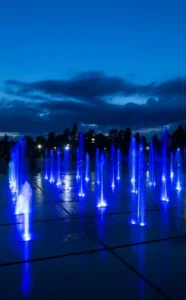- Product Knowledge
What is Architectural Linear Lighting?
Architectural linear lighting is transforming the way designers illuminate spaces, merging functionality and aesthetics to spotlight architectural forms and enhance spatial ambiance. Widely utilized in commercial, industrial, and even residential environments, this versatile lighting solution is designed to create a linear beam of light using elongated, narrow fixtures. These fixtures, often crafted from metal or durable plastic, can be installed on walls, ceilings, or floors, making them adaptable to various architectural needs.

Why Architectural Linear Lighting?
Architectural linear lighting goes beyond mere illumination. It plays a crucial role in architectural lighting design, where the placement and design of light fixtures help to highlight architectural features, create desired focal points, and maintain a balanced visual appeal. Effective architectural lighting doesn’t just showcase the beauty of a space—it also ensures ergonomic and functional lighting suited to the space’s purpose, meeting both aesthetic and safety needs.
What Qualifies Linear Lighting as Architectural?
For linear lighting to qualify as architectural, it must be both purposeful and artfully designed, elevating the room’s overall aesthetic. Architectural lighting solutions should meet specific ergonomic needs, providing ample light while drawing attention to dramatic design elements. In these setups, luminaires are often strategically positioned to enhance a room’s structural aspects, using lighting to emphasize the flow and character of the space. Well-executed architectural lighting achieves a harmonious balance between art and function, offering both ample visibility and visual appeal.
Types of Architectural Linear Lighting Fixtures
When it comes to linear lighting in architectural design, there are several fixture options, each offering unique effects and suited for different settings. Here are the three primary types:
1. Recessed Linear Fixtures
Recessed linear fixtures are installed directly into the ceiling, flush with its surface for a clean, minimalistic look. This design provides a diffused, soft light ideal for general illumination, making it an excellent choice for environments requiring uniform lighting without visible fixtures disrupting the ceiling line. Recessed fixtures are particularly suitable for settings where a smooth and seamless lighting source is desired.
2. Surface-Mounted Linear Fixtures
Surface-mounted linear fixtures are affixed to the exterior surface of walls or ceilings, providing a more direct lighting solution. These fixtures work well for accent lighting or to emphasize specific architectural details, as their positioning offers focused light where it’s needed most. Surface-mounted fixtures are a popular choice for spaces that require more pronounced lighting effects to highlight design elements without the need for in-ceiling installations.
3. Suspended Linear Fixtures
Suspended linear fixtures, as their name suggests, hang from the ceiling. This design offers a striking lighting effect, often creating a dramatic focal point in the room. These fixtures not only provide diffused general illumination but can also act as visual dividers within open spaces. Ideal for expansive rooms, suspended fixtures are excellent for creating ambiance and defining different areas while maintaining a cohesive look.
Choosing the Right Linear Fixtures for Architectural Lighting
Selecting the appropriate linear fixtures is crucial for achieving desired lighting effects and meeting spatial requirements. Architectural linear lighting serves various purposes, from creating subtle ambient lighting to producing bold accent lighting that adds drama to a space. When choosing fixtures, consider the room’s dimensions, the required light output, and the intended lighting effects.
For larger commercial areas, an efficient approach is to install extended rows of linear fixtures, either seamlessly connected to form a continuous line of light or spaced apart to allow each fixture to stand alone. This type of design is particularly effective in large open spaces, where a mix of ambient and accent lighting can define the room’s mood. Additionally, geometric arrangements of linear fixtures can introduce a memorable and visually impactful effect, enhancing the overall architectural design.
Enhancing Visual Quality with Architectural Linear Lighting
Leading brands like Lumato offer comprehensive linear fixture solutions, designed to elevate the visual quality of any architectural space. Their collections include recessed, surface-mounted, and suspended fixtures, ensuring options for all design needs. Quality linear lighting fixtures should be both functional, providing adequate light, and visually integrated, complementing the space’s chosen aesthetic without overpowering it.
Incorporating architectural linear lighting in design projects brings the flexibility to create impactful lighting environments that blend function and art. Whether aiming for minimalistic ambient lighting or striking focal points, linear fixtures offer an adaptable solution that enhances and complements architectural elements within any space.



